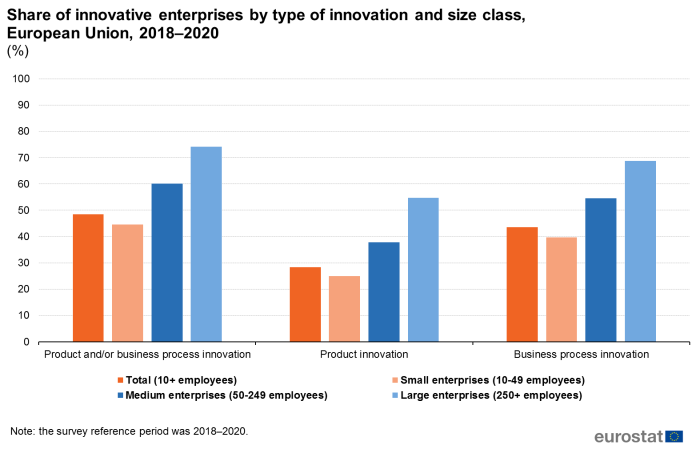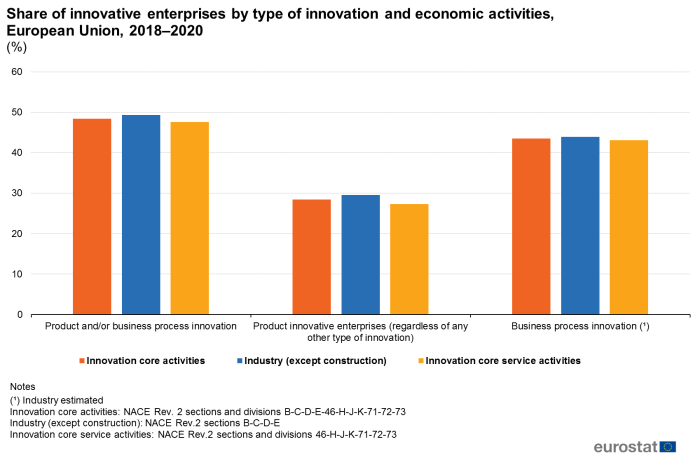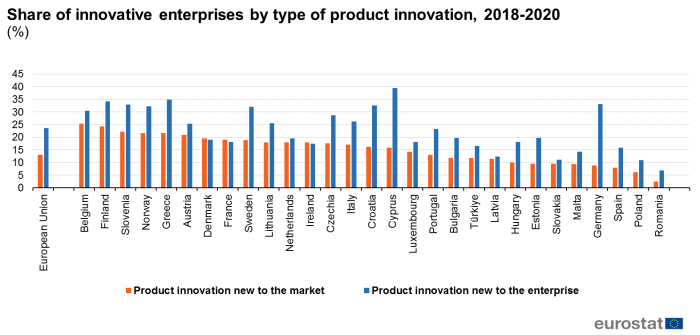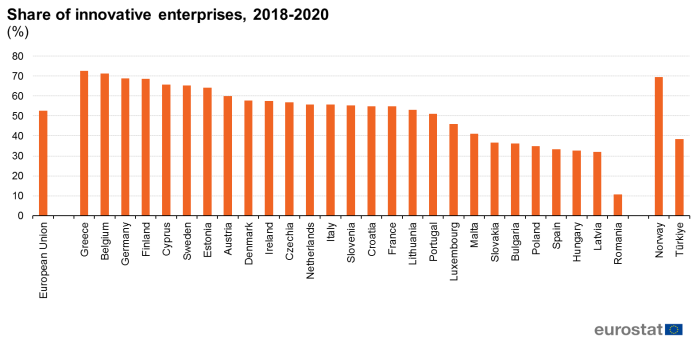Community Innovation Survey 2020 - key indicators
Data extracted in November 2022
Planned article update: November 2024
Highlights
More than half of all the enterprises in the EU Member States reported some form of innovation activity during the reference period 2018–2020
Among the medium-size enterprises, more than half are business process innovators, while the share of product innovators is below 40%
In seven EU Member States, less than one-tenth of all enterprises introduced product innovations that were new to the market
Share of innovative enterprises, 2018-2020
The innovative behavior of enterprises plays a central role in shaping innovation performance at the sectoral and national levels. Since its first launch, dating back to the 1990s, the Community Innovation Survey (CIS) has represented a unique information source for business analysts and policy-makers by focusing on a wide range of aspects of the innovation process undertaken by European enterprises. The CIS survey has undergone a substantial restructuring for the CIS 2018 wave. More information about the nature and objectives of the changes can be found in the background article: Community Innovation Survey - new features.
This short article will present a brief overview of the survey results over the period 2018-2020 (CIS 2020). It will focus on key indicators, namely the share of innovative enterprises, the kinds of innovation developed and introduced, and the types of product innovation according to the level of novelty. The complete dataset is available in the section Science, Technology and Innovation.
Full article
Innovation activity in the European Countries
More than half of all the enterprises in the EU Member States reported some form of innovation activity (52.7 %) during the reference period 2018–2020[1]. Figure 1 provides the share of innovative enterprises by country. Among the EU Member States, the highest proportions of innovative enterprises were observed in Greece (72.6 % of all enterprises), Belgium (71.3 %), Germany (68.8 %) and Finland (68.7 %), while Cyprus, Sweden and Estonia also recorded proportions that were above 60.0 %. The lowest levels of innovative activity were recorded in Romania (10.7 %).
Types of innovation introduced
Figure 2 analyses the types of innovation introduced by enterprises, namely product innovation and business process innovation; the information is presented for all enterprises (with 10 or more employees), for small enterprises (10-49 employees), for medium enterprises (with 50–249 employees) and for large enterprises (with 250 or more employees).

Source: Eurostat (inn_cis12_bas) and (inn_cis12_spec)
With the changes introduced by the CIS revision, the definition of business process innovation merges the previous questions on process, marketing and organisational innovation and, thus, includes all the business functions related to both the core activity of producing and delivering products for sale and other supporting operations characterising the most advanced services' activities. One element of prior marketing innovation has been moved to product innovation[2] - significant changes to product design. This shift inevitably leads to a revised definition of product innovation that now also refers to changes in design.[3]
In the EU Member States, almost half of all enterprises (48.4 %) introduced product and/or business process innovations during the 2018-2020 period (Figure 3). The distribution of innovative firms by size (Figure 2) reflects the pattern of the reference population of firms, given that the vast majority are small enterprises. Indeed, the share of innovators in small enterprises is not far from that of the total population (44.5 %). By contrast, there was a different pattern for medium and large enterprises as, on average, these were more likely to have introduced innovations than the smaller ones (60.1 % and 74.1 %, respectively); this observation held consistently across both types of innovation.
Almost seven out of ten large enterprises introduced a business process innovation (68.8 %) and more than half a product innovation (54.7 %). Among the medium enterprises, more than half are business process innovators (54.5 %), while the share of product innovators is below 40 %. In the vast majority of firms characterised as small enterprises, almost four out of ten are process innovators. By contrast, the share of product innovators is much lower, around one-quarter of the small-sized firms.

Source: Eurostat (inn_cis12_bas) and (inn_cis12_spec)
The distribution of innovative enterprises remains mostly the same across the industry and services NACE sectors (Figure 3). The CIS core activities in the industry include the mines and queries and the manufacturing sectors and exclude constructions; the services include wholesale trade, transport, storage, information and communication activities, financial intermediation, computer and related activities and other business-related services.
The share of innovators is only slightly higher in the industry than in the total core activities (49.3 % vs. 48.4 %) and the higher contribution of product innovation on average guides this difference compared with the services (29.5 % and 27.3 %, respectively).
Product innovation and novelty
According to the CIS definitions, product innovation requires an enterprise to have introduced a new or a significantly improved product. A distinction may be made between those product innovations that are new to the market or those which are new only to the innovating enterprise. During the period 2018–2020, more than one-fifth of all enterprises in Belgium, Finland, Slovenia, Greece and Austria were product innovators with goods or services that were new to the market (Figure 4). There were seven EU Member States where less than one-tenth of all enterprises introduced product innovations that were new to the market, with the lowest share in Romania (2.4 %). As regards product innovations that were new to the enterprise, fourteen of the EU Member States reported shares of more than one-fifth, with the highest share recorded in Cyprus (39.5 %). The lowest percentage is registered in Romania (6.8 %).

Source: Eurostat (inn_cis12_prodt)
Source data for tables and graphs
Data sources
The Community Innovation Survey (CIS) is a survey about innovation activities in enterprises. The survey is designed to capture the information on different types of innovation, to enable analysis of innovation drivers or to assess the innovation outcomes. The survey focuses, among others, on the following aspects:
- innovation activities,
- innovation expenditure,
- innovative products (new to firm; new to the market),
- turnover from innovative products,
- business process innovation,
- incentives for implementation of innovation,
- innovation cooperation,
- source of financing of innovation,
- sources of information on innovation,
- innovation barriers, etc.
The information collected allows measuring the innovativeness of business sectors (B-C-D-E-46-H-J-K-71-72-73).
The CIS provides various innovation indicators by three main breakdown variables: type of innovator, economic activity and size class of enterprise. The following size classes of enterprises according to number of employees are included in the core target population of the CIS 2018:
- 10 - 49 employees: small enterprise
- 50 - 249 employees: medium-size enterprise
- 250 or more employees: large enterprise
The innovation survey was first launched in the 1990s and became a regular biennial data collection starting from CIS4 (2004) in the EU Member States, EFTA countries and EU candidate countries. Since its launch the survey was based on the methodology laid down in the Oslo Manuals — international standards for conceptualising and collecting data on innovation. The first Oslo Manual was published in 1992. It has been revised on three occasions to take into account the experience and expand its measurement framework — in 1997, 2005 and in 2018. The CIS 2018 is the first CIS after the review of the Oslo Manual in 2018, resulting in its 4th edition (Oslo Manual (2018), 4th Edition).
For each survey round, Eurostat together with the countries develops a standard core questionnaire – Harmonised Data Collection (HDC) – listing the mandatory and rotational questions to be provided within a given round. The questionnaire includes the set of definitions and methodological recommendations to assure comparability among countries.
Eurostat provides an overview of all variables used in any CIS rounds since 1992 in its 'Living Library'. This service is used, e.g., by data professionals, researchers, academia and designers of innovation surveys. The 'Living Library' allows browsing by themes, such as innovation topics or questions, as well as questionnaires (survey rounds). It also provides an overview matrix that relates one to the other.
CIS 2020 results are collected under Commission Regulation No 995/2012. This Regulation defines the mandatory target population of the survey referring to enterprises in the core NACE categories with at least 10 employees. Eurostat recommended using 'person employed' as a size class unit in order to comply with the latest measurement standards in European business statistics and recommendations of the Oslo Manual, 4th edition. The standard mandatory questions refer to the number of innovative enterprises, products and goods new to the market and new to the firm, innovation cooperation, objectives of innovation, sources of information for innovation, hampering factors, innovation developer, turnover from innovation and expenditure on innovation. The following questions were new in CIS 2018: customisation and co-creation, patents and IPRs, buying technical services, innovative purchases, using information channels, organising work and expectations from innovation.
Most statistics in CIS 2020 are based on the 3-year reference period 2018-2020, but some use only one calendar year (2018 or 2020).
Context
Within the statistical information system on science, technology and innovation, business innovation statistics represent a crucial piece of knowledge to support and monitor EU policies.
Under the umbrella of the Commission Regulation (EU) 2152/2019 , innovation statistics will be better integrated into the context of European Business Statistics. The redesign of the CIS has anticipated this critical change, thus allowing for an increase in the harmonisation of the CIS data among business statistics. This change represents a necessary step to have data more and more harmonised among the EU countries, thus supporting EU policy monitoring. Also, the integration of data on business innovation will allow for a better understanding of the economic determinants and consequences of innovation.
In the Innovation Union flagship initiative, the European Innovation Scoreboard provides a comparative analysis of innovation performance in EU countries, other European countries and regional neighbours. It assesses the relative strengths and weaknesses of national innovation systems and helps countries identify areas they need to address. The regional extension, the Regional Innovation Scoreboard, is relevant for assessing the innovation performance across 240 regions of 22 EU countries using a limited number of indicators.
Data on business innovation are a basis for the Commission's report Science, Research and Innovation Performance of the EU (SRIP). The report provides a thorough analysis of the research and innovation performance in Europe and formulates recommendations for the future.
Under the European Green Deal it will be crucial in the following years to trace the technological change that the green economy transition will determine in the medium to long term. The CIS will be the natural source of information to provide data on innovations with environmental benefits and data on the perceived relevance of climate change for businesses to support related policymaking.
Direct access to
See also
Main tables
- Community innovation survey (inn)
- Community innovation survey 2020 (inn_cisl2)
Database
- Community innovation survey (CIS)
- Results of the community innovation survey 2020 (CIS2020) (inn_cis12)
Dedicated section
Publications
Methodology
- Oslo Manual
- Community innovation survey 2020 (CIS2020) (inn_cis12) (ESMS metadata file — inn_cis12)
External links
Notes
- ↑ The types of activities included are: Successfully introduced product or process innovation; Completed innovation activities that have not yet resulted in the implementation of an innovation; On-going innovation activities, with work in progress that has not yet resulted in the implementation of an innovation; Abandoned innovation activities before the implementation of an innovation; any R&D activity.
- ↑ A product innovation is a new or improved good or service that differs significantly from the firm's previous goods or services and that has been introduced on the market.
- ↑ This change has an unavoidable impact on the direct comparability with previous waves. For more details see Community Innovation Survey - new features.
